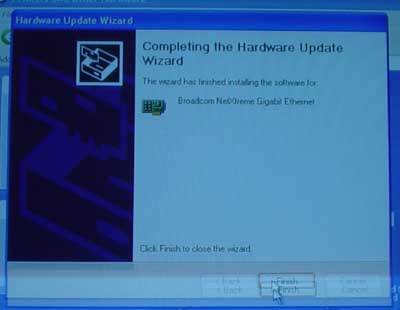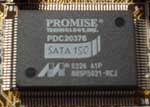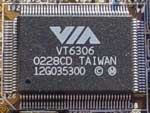ASUS A7V8X (KT400): The Athlon Gets DDR400
by Evan Lieb on September 6, 2002 11:46 AM EST- Posted in
- Motherboards
ASUS A7V8X: Basic Features
|
Motherboard Specifications |
|
|
CPU
Interface
|
Socket-462
|
|
Chipset
|
VIA
VT8368 North Bridge
VIA VT8235 South Bridge |
|
Bus
Speeds
|
100
- 227MHz (in 1MHz increments)
|
|
Core
Voltages Supported
|
up
to 1.85V in 0.025V increments (overvolt jumpers go up to 2.05V core)
|
|
I/O
Voltages Supported
|
N/A
|
|
DRAM
Voltages Supported
|
up
to 2.8V in 0.1V increments
|
|
Memory
Slots
|
3
184-pin DDR DIMM Slots
|
|
Expansion
Slots
|
1
AGP 8X Slot
6 PCI Slots |
|
Onboard
RAID
|
Promise
PDC20376 Serial ATA 150 RAID
|
|
Onboard
USB 2.0/IEEE-1394
|
USB
2.0 and VT6306 1394(a) FireWire
|
|
Onboard
LAN
|
Broadcom
5702 Gigabit Ethernet
|
|
Onboard
Audio
|
Realtek
6-channel ALC200 AC'97
|
As we usually do, we'll start off this section by taking a look at some of the more basic features of the ASUS A7V8X motherboard.
First up are the I/O ports, which are nearly identical to all the other I/O configurations we've seen on the market (including KT400 boards from Gigabyte and MSI). You have your standard I/O ports with this motherboard; 2 PS/2 ports, 2 serial ports, 1 parallel port, some USB 2.0 ports (4), and 3 audio jacks.
 Worth
special mention is the onboard Gigabit LAN. Gigabit is made possible by an onboard
LAN chip from Broadcom, dubbed the 5702, the same chip the MSI 648 Max uses.
While Gigabit is certainly a welcome addition to any motherboard, there's simply
no need for this technology for most users, even though it offers 10 times the
bandwidth of conventional 10/100 Ethernet devices (Gigabit offers approximately
1000Mbps of bandwidth). Gigabit is more useful for corporations looking to configure
large, safe, and expensive networks, so most users (especially your average
Joe Blow) won't benefit from this feature. Enabling Gigabit functionality was
a breeze, it was no more difficult than setting up any other 10/100 device.
Worth
special mention is the onboard Gigabit LAN. Gigabit is made possible by an onboard
LAN chip from Broadcom, dubbed the 5702, the same chip the MSI 648 Max uses.
While Gigabit is certainly a welcome addition to any motherboard, there's simply
no need for this technology for most users, even though it offers 10 times the
bandwidth of conventional 10/100 Ethernet devices (Gigabit offers approximately
1000Mbps of bandwidth). Gigabit is more useful for corporations looking to configure
large, safe, and expensive networks, so most users (especially your average
Joe Blow) won't benefit from this feature. Enabling Gigabit functionality was
a breeze, it was no more difficult than setting up any other 10/100 device.

Moving along we see two IDE connectors, the primary and secondary connectors, which are right above the floppy connector. No surprise, they offer support for 2 channels, or up to 4 IDE devices.
A little further down we notice the interesting positioning of the Promise Serial ATA RAID connector. The RAID connector is positioned horizontally instead of vertically, and at the very edge of the lower right half portion of the PCB. ASUS hasn't gotten back to us on how many channels it supports, but it'll be at least two obviously. Even though this particular Promise RAID controller is SATA, it can still support ATA133 in addition to RAID 0 and RAID 1 arrays (no RAID 0 + 1 though). As you'd expect, there are SATA connectors onboard, two in all. As with all other SATA technologies at the moment, ATA150 (150MB/s transfer rate) is supported.

Some other nice features of this motherboard include the addition of 1394(a) FireWire via a VIA VT6306 controller. There are 2 FireWire connectors situated at the very bottom edge of the board for your pleasure. Since the VIA KT400 chipset doesn't natively support FireWire, it makes all the sense in the world to tact on an onboard controller like the VT6306.

ASUS also throws in its patented Q-fan control option in the BIOS. Essentially, Q-Fan regulates your CPU's fan speed depending on how taxed your system is at that moment. The obvious benefits of this technology are lower operating temperatures.












1 Comments
View All Comments
SoSolid - Saturday, July 26, 2003 - link
Today I discoverd that the fifth PCI slot of my Gigabyte GA-7VTXE+ was malfuntioning. As a Gigabyte fan my first thought was to buy a new Gigabyte mothterboard.However I recall it was much more expensive than the upcoming 333MHz boards. So I decided to look around for an other board. Today I heared about the Asus A7V8X-X. After reading various information and this review I believe buying the A7V8X(-X) will be the right choice.